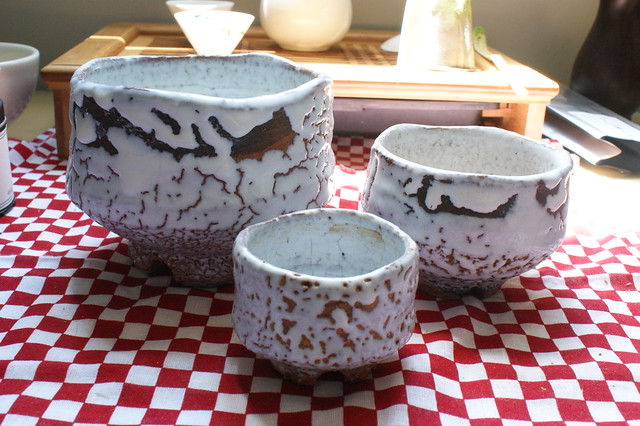
I'm going to try and be as unbiased on this piece as possible, but I may wavery between hyper critical, and overly lovey dove-y with this piece. This piece I actually made the form of on my very first day of ceramics class, but actually makes a decent chawan. It is pinch-work with a coil foot. Sadly its quite wonky even for a pinchwork piece, due in part to the clay still being quite wet and weak when I attached the foot, so one side of the bowl is drooping.

The glazing of this piece was a huge lesson in how unpredictable glazing can be. I call this Chawan my Painted teabowl, because the effect is it looks almost painted ( not in any particular design, but just painted, with earthy colors). I had actually imagined a far more edgy piece, that had huge contrast, between white, black and dark green. But as I am sure the experienced potters (if there are any) that read this blog, will subtly laugh at my intent while reading this, but for the most part I was treating glazing more like painting as in, whats on top is what will be seen. I by no means considered that yes this when it is fired melts substantially then hardens again into basically a glass on the surface of the piece.
So the glazing of this piece, as I wanted that very bright white background, and looking at the test tiles, one coat did not look as white as I wished. So I did two dips into the white glaze, then took a calligraphy brush, and did subtle brush strokes of Tenmoku on opposite sides, and Oribe on the other two sides. Tenmoku of course being a black glaze, and Oribe being a dark vibrant green. Well I can understand what the Tenmoku did, as I only did a single brush stroke, and brushing glaze onto a piece does not apply it incredibly thick, and tenmoku when applied thin tends to be a browner glaze. The Oribe though still throws me for a loop, somehow the thin layer combining with the white glaze turned purple, but even more so developed a texture different from the rest of the piece.

This piece actually handled its first bowl of matcha surprisingly well. While it will by no means become a regular teabowl that I use, in part because the drooping around the outside of the foot, caused a rim around the outside of the piece in which the liquid settles, and is actually somewhat hard to completely drain from the piece.
All in all I think it's a great first usable piece made by me. While it is far from the look I was going for, it developed a rather rustic look, with a color palate similar to some pottery I have seen from the western United States, mainly in the Rocky Mountain, or Southwest region.





























